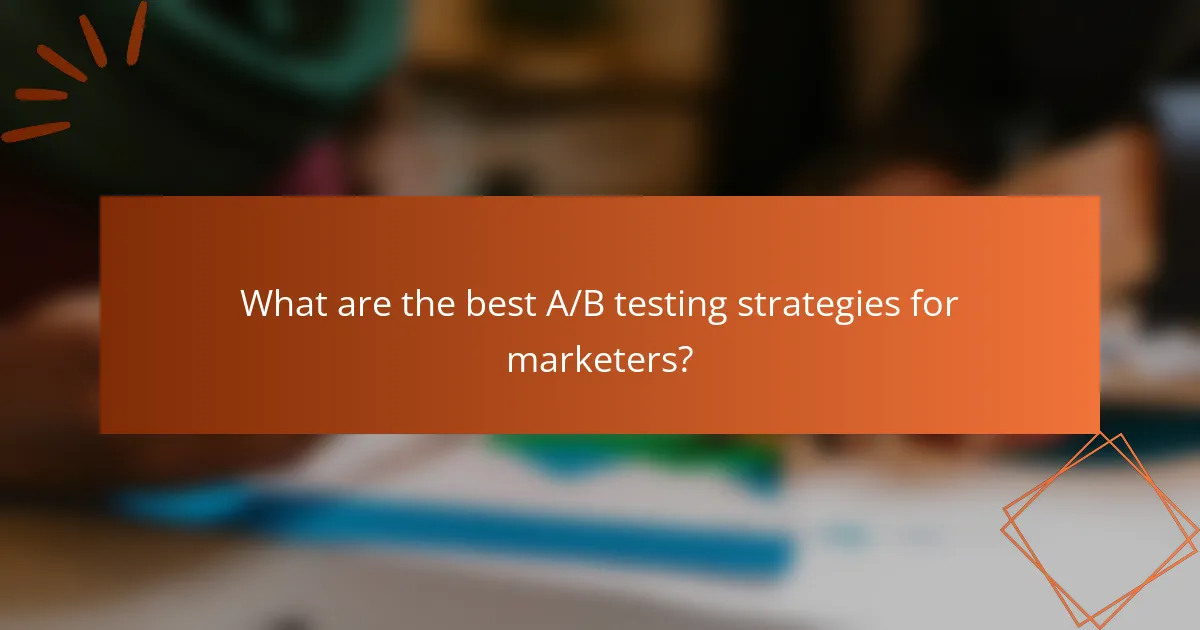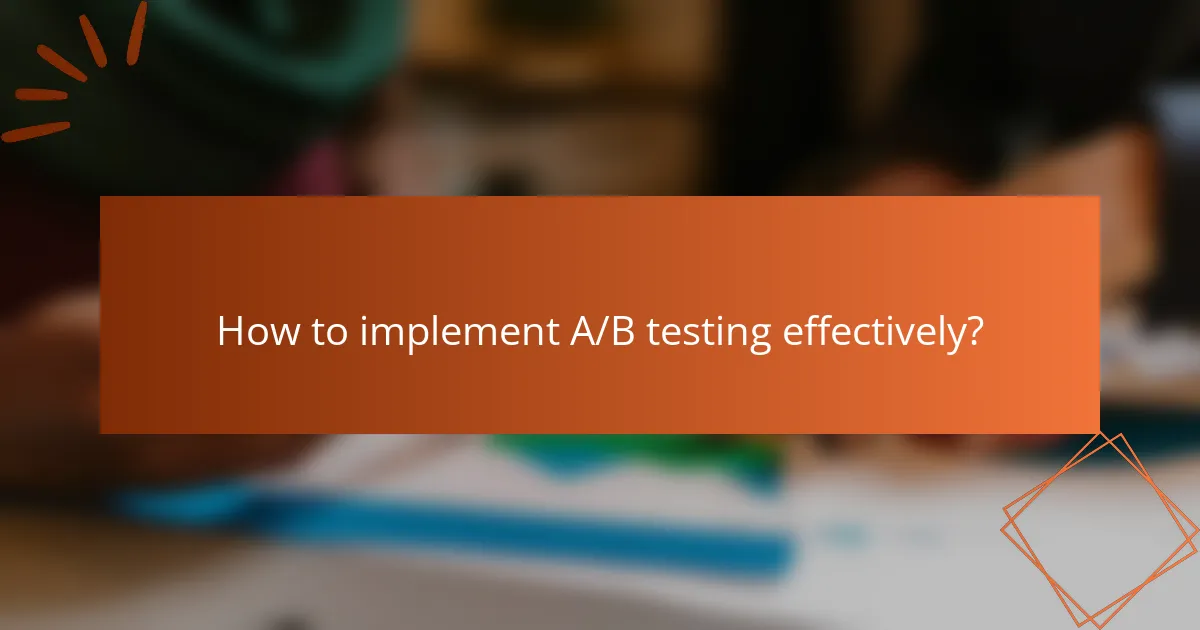A/B testing is a powerful method for marketers to optimize website performance and enhance user engagement by comparing two versions of a webpage or app. By employing various strategies such as split URL testing and multivariate testing, businesses can identify effective approaches that lead to improved outcomes. To achieve the best results, it’s essential to define clear goals and utilize the right tools during the implementation process.

What are the best A/B testing strategies for marketers?
The best A/B testing strategies for marketers include split URL testing, multivariate testing, sequential testing, mobile optimization strategies, and personalization techniques. Each strategy offers unique advantages and considerations that can significantly enhance marketing effectiveness.
Split URL testing
Split URL testing involves creating two separate URLs for different versions of a webpage to measure performance. This method is particularly useful for testing major changes, such as layout or design, as it allows for clear data collection on user interactions with each version.
When implementing split URL tests, ensure that traffic is evenly distributed between the two URLs to achieve reliable results. Tools like Google Optimize or Optimizely can facilitate this process by managing traffic and data collection.
Multivariate testing
Multivariate testing examines multiple variables simultaneously to determine which combination performs best. This approach is ideal for optimizing elements like headlines, images, and calls to action on a single page.
To effectively conduct multivariate tests, identify key elements to test and use a robust testing tool that can handle the complexity of multiple variations. Keep in mind that this method requires a larger sample size to yield statistically significant results.
Sequential testing
Sequential testing involves running tests one after another rather than simultaneously. This strategy can be beneficial when resources are limited or when testing requires significant changes that may impact user experience.
When using sequential testing, analyze the results of each test before proceeding to the next. This method allows for iterative improvements but may take longer to reach conclusive insights compared to simultaneous testing methods.
Mobile optimization strategies
Mobile optimization strategies focus on enhancing the user experience for mobile users through A/B testing. Given the increasing use of mobile devices, it’s crucial to test elements like button sizes, loading times, and content layout specifically for mobile screens.
Consider using responsive design techniques and ensuring fast loading times, ideally under three seconds. Tools like Google PageSpeed Insights can help identify areas for improvement in mobile performance.
Personalization techniques
Personalization techniques involve tailoring content and experiences to individual users based on their behavior, preferences, or demographics. A/B testing can help determine which personalized elements resonate most with different audience segments.
To implement effective personalization, gather data on user interactions and preferences, then test variations of personalized content. Be cautious of over-personalization, which can lead to privacy concerns or user discomfort.

What are the benefits of A/B testing?
A/B testing offers several advantages, including the ability to identify effective strategies for improving website performance and user engagement. By comparing two versions of a webpage or app, businesses can make informed decisions that lead to better outcomes.
Improved conversion rates
A/B testing directly contributes to improved conversion rates by allowing businesses to test different elements, such as headlines, images, or call-to-action buttons. For instance, a simple change in button color or text can lead to significant increases in user actions, such as signing up for a newsletter or making a purchase.
To maximize conversion rates, focus on testing one variable at a time. This approach helps isolate the impact of each change, making it easier to determine which version performs better.
Data-driven decision making
With A/B testing, decisions are based on actual user behavior rather than assumptions or gut feelings. This data-driven approach enables marketers to understand what resonates with their audience, leading to more effective strategies.
Utilize analytics tools to track performance metrics during tests. Key indicators like click-through rates and conversion rates provide valuable insights that can guide future marketing efforts.
Enhanced user experience
A/B testing enhances user experience by allowing businesses to tailor their offerings to meet user preferences. By identifying which design or content elements users find most appealing, companies can create a more engaging and satisfying experience.
Consider testing various layouts or content formats to see what keeps users on the page longer. A positive user experience can lead to increased loyalty and repeat visits.
Reduced bounce rates
Implementing A/B testing can help reduce bounce rates by identifying which elements keep visitors engaged. By testing different headlines, images, or layouts, businesses can discover what encourages users to stay on the site longer.
To effectively lower bounce rates, focus on creating compelling content and a clear navigation structure. Regularly testing these elements ensures that the website remains appealing and user-friendly.

How to implement A/B testing effectively?
To implement A/B testing effectively, start by defining clear goals and selecting the right tools. This structured approach maximizes the insights gained from your tests, leading to better decision-making and improved outcomes.
Define clear objectives
Establishing clear objectives is crucial for A/B testing success. Define what you want to achieve, whether it’s increasing conversion rates, improving user engagement, or enhancing customer satisfaction. Specific goals help in designing tests that yield actionable insights.
For example, instead of a vague goal like “improve website performance,” aim for “increase newsletter sign-ups by 20% over the next month.” This clarity guides your testing strategy and metrics for evaluation.
Select appropriate tools like Optimizely
Choosing the right A/B testing tools is essential for effective implementation. Optimizely is a popular choice due to its user-friendly interface and robust features, allowing you to create and manage tests easily. Other options include VWO and Google Optimize, each offering unique capabilities.
When selecting a tool, consider factors such as ease of use, integration with existing systems, and pricing. Ensure the tool can handle the scale of your testing needs and provides reliable analytics to track performance.
Establish a testing timeline
A well-defined testing timeline helps maintain focus and ensures that tests are conducted efficiently. Determine how long each test should run, typically ranging from a few days to a few weeks, depending on your traffic volume and the significance of the results.
Consider seasonal trends and user behavior when setting your timeline. For instance, avoid running tests during holidays or major events that could skew results. A consistent schedule allows for better comparison across tests.
Analyze results with Google Analytics
Analyzing results is a critical step in A/B testing. Google Analytics provides powerful tools to evaluate the performance of your variations. Set up goals and funnels to track user interactions and conversions effectively.
After the test concludes, compare the performance metrics of each variant. Look for statistically significant differences in conversion rates or other key performance indicators. This analysis informs whether to implement the winning variation or iterate further.

What are the common pitfalls in A/B testing?
Common pitfalls in A/B testing can lead to misleading results and ineffective decision-making. Understanding these pitfalls is crucial for conducting successful tests that yield actionable insights.
Insufficient sample size
Using an insufficient sample size can skew results and lead to inconclusive findings. A small sample may not accurately represent the larger population, increasing the risk of Type I and Type II errors. Aim for a sample size that provides a confidence level of at least 90% to ensure reliability.
To determine the appropriate sample size, consider factors like the expected conversion rate, the minimum detectable effect, and the desired statistical power. Tools and calculators are available online to assist in this process.
Ignoring statistical significance
Ignoring statistical significance can result in drawing incorrect conclusions from A/B tests. It’s essential to analyze whether the observed differences between variants are statistically significant rather than due to random chance. A common threshold for significance is a p-value of less than 0.05.
Always report and interpret statistical significance in the context of your business goals. This ensures that decisions are based on solid evidence rather than assumptions or anecdotal observations.
Testing too many variables at once
Testing multiple variables simultaneously can complicate the analysis and obscure which changes are driving results. This approach, known as multivariate testing, can dilute the impact of individual changes and lead to confusion about what works best.
To avoid this pitfall, focus on one variable at a time per test. This allows for clearer insights and more straightforward conclusions. If you wish to test multiple elements, consider running sequential tests or using a structured framework to isolate effects effectively.

What tools can enhance A/B testing?
Several tools can significantly improve A/B testing by providing insights, facilitating design changes, and tracking results. Choosing the right tool depends on your specific needs, such as visual testing capabilities, user experience analytics, and integration with existing systems.
VWO for visual testing
VWO (Visual Website Optimizer) is a powerful tool for visual testing that allows marketers to create and run A/B tests without needing extensive coding knowledge. It provides a user-friendly interface where you can easily modify website elements and see how changes affect user behavior.
When using VWO, consider its features like heatmaps and session recordings, which help you understand user interactions on your site. This insight can guide your testing strategy by highlighting areas that may benefit from optimization.
To maximize the effectiveness of VWO, focus on testing high-traffic pages first and ensure that your sample size is adequate to achieve statistically significant results. Avoid making too many changes at once, as this can complicate the analysis of which specific change drove any observed improvements.

